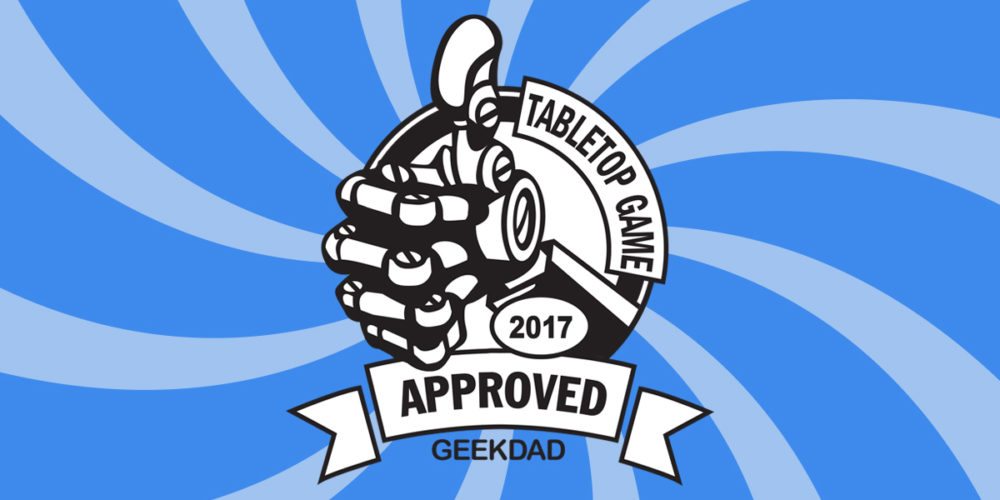
Vegas Dice Game is a new quick, easy-to-learn press-your-luck game from Ravensburger. The game is due to be officially unveiled at Gen Con next week, but they sent me an advance copy to take a look at beforehand.
At a Glance
In Vegas Dice Game, players take turn rolling their dice and placing them on boards that have various amounts of money to win. Whoever has the most dice on the board wins the money, but be careful–if you and another play tie, no one gets anything. The game is for 2-5 players. The box says that games take about 30 minutes, but no game we’ve played has lasted for more than 15. It also says 8+, but as long as younger kids can count up to eight they could play it.
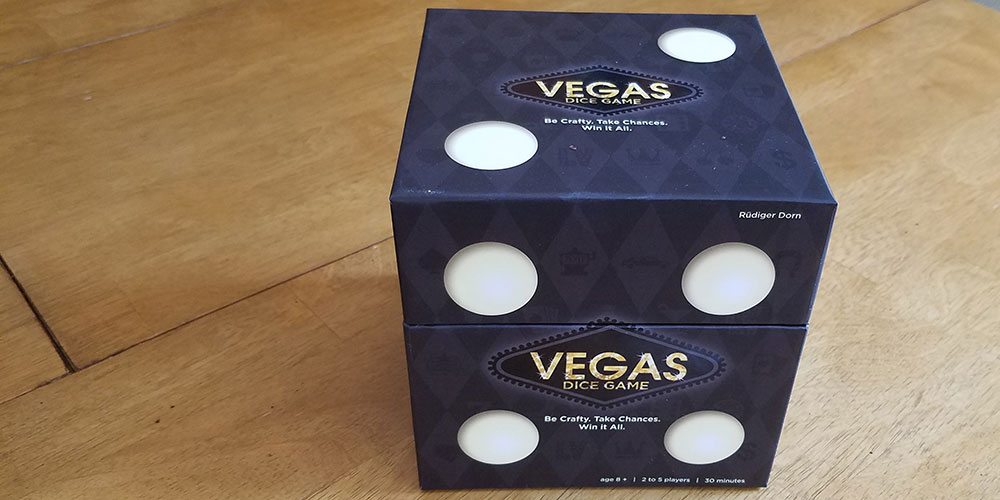
Components
The cool dice-shaped box contains:
6 casino table boards
40 dice: 8 each in the five player colors
54 cards representing the money, in denominations from $10,000 to $90,000
1 starting player card
1 storage bag for the dice
Vegas Dice Game is GeekDad Approved!
How to Play
Setup is quick and easy: place the six casino table boards on the table in numerical order. Then, shuffle the money cards and deal cards out to each board until the total is greater than or equal to $50,000. Sometimes this will mean there’s only one card, since you stop immediately if you deal a $50,000, $60,000, $70,000, $80,000, or $90,000 card. Other times, there will be two or three (or, rarely, even four) cards dealt to each table.
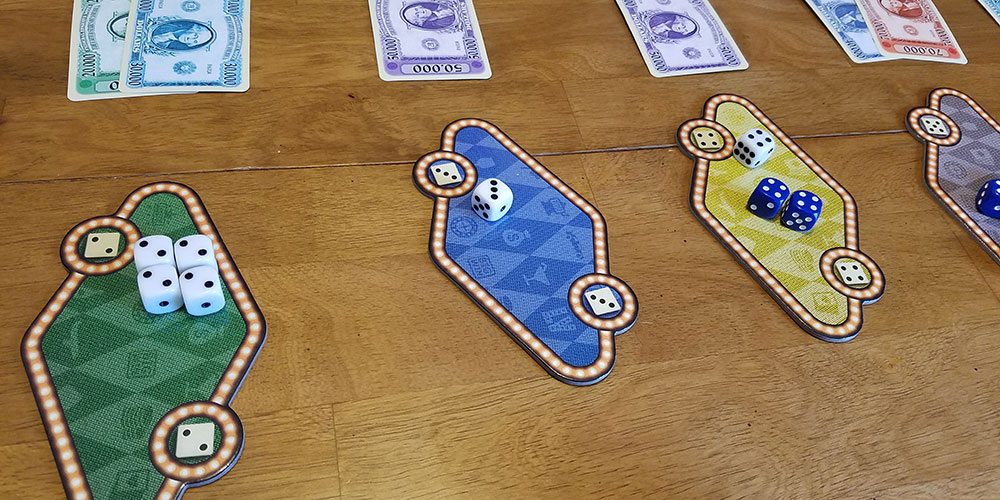
Each player takes the eight dice of their color. The oldest player gets the starting player card first.
Beginning with the starting player, each player rolls their dice. Then, they take all of the dice of one number and place them on the board of their choice. For example, if a player’s roll give them 1, 3, 3, 3, 4, 4, 5, and 6, they could place their single 1 on the one board, all three 3s on the three board, both 4s on the four board, their single 5 on the five board, or their single 6 on the six board. The only catch is that they must place all of the dice of a single number on the board, so in the example above they could not choose to only put two 3s on the three board–the have to do all three.
Once they place their dice, the next player does the same. Play continues around the table until everyone has placed all of their dice. This might (and very often does) mean that one or two players may get a few extra rolls if they are placing fewer dice per turn.
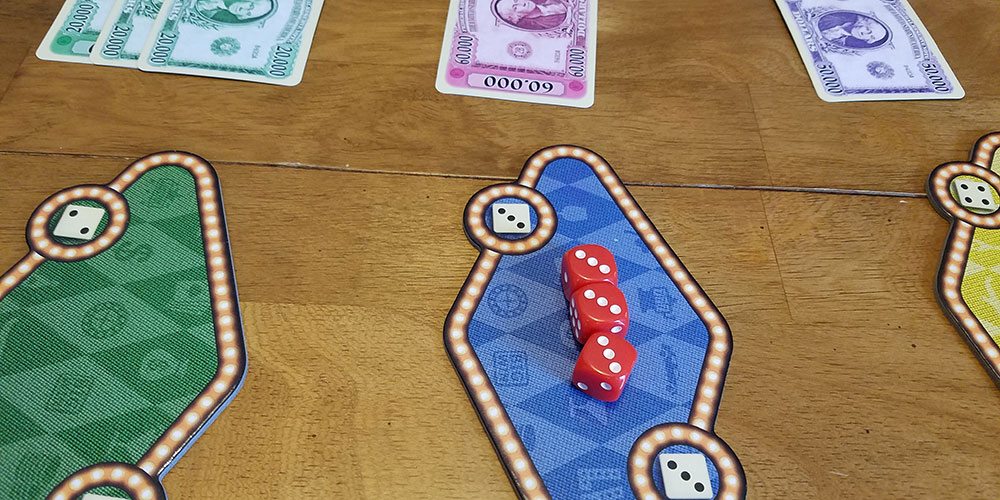
When everyone has finished placing all of their dice, the money from each table is distributed. If there’s a single bill, it goes to the player with the most dice on that board. If there are two bills, the player with the most dice gets the highest denomination bill, and then the second player gets the second highest, and so forth.
However, there’s a bit of a catch to this: if two or more players tie for the number of dice on a board, all of their dice are removed and don’t count. So, if the blue and the red players each had four dice on a board, and the green player only had one, the blue and red players are disqualified, and the green player wins that board. If no one is left after removing the ties, then that money is simply not distributed and those bills are discarded.
This is the brilliant part of the game since it changes the game from being almost entirely about luck to one with a surprising amount of strategy. If you are competing with another player for a board, and you have one fewer dice on the board than they do, do you go ahead and place your singleton of that number this round, hoping that you will roll that number on a subsequent turn and end up winning, but also taking the chance that you won’t roll it and thus disqualify both of you? Or do you play it safe and wait until you get enough to clearly win the board, again gambling that that will happen?
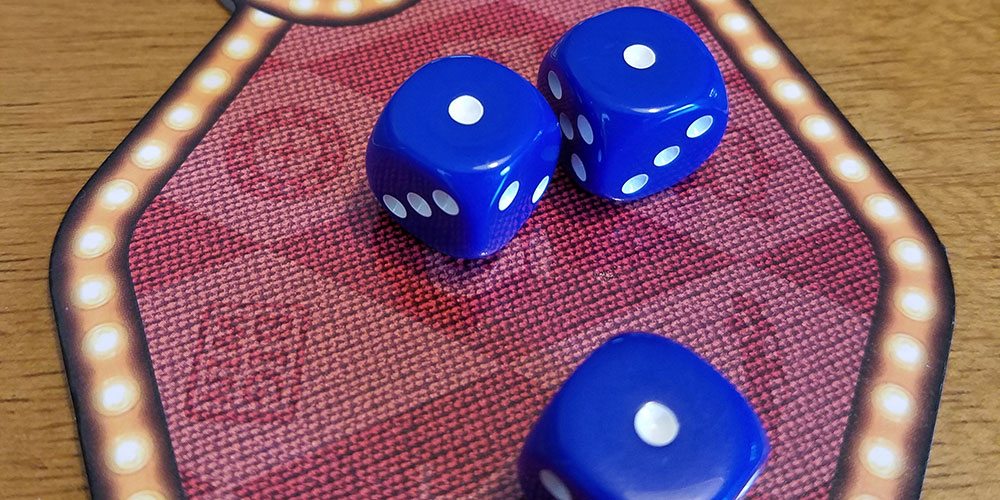
The disqualification rule also means that no board is truly won until the end. We’ve had several occasions in playing it where two players are fiercely competing for a board with a $90,000 bill on it. But on the final roll, another player happens to roll that number with their final die, and because the two players who were competing end up tying, that $90,000 win goes to the one with the single die.
The final roll, by the way, is also an interesting component, because you simply must place that last die on whatever number it happens to come up on. Sometimes that means it’s basically wasted–you roll a 4, and another player already has five dice on that board. But other times, it matters a lot. There are the scenarios like the one I mentioned above where that final roll allows you to swipe a board away from others who are tied. Or, it might bring you into a tie, ruining the plan you had to go ahead and place second on a board with multiple bills and meaning that you end up getting nothing.
The game is played over four rounds. After each round, unclaimed money is discarded, new money is dealt to each table, and the starting player card is passed to the left. At the end of the last round, everyone tallies their money and whoever has the most wins. In case of a tie, whoever has the most physical bills wins.
Verdict
Vegas is a new, Target-exclusive version of Las Vegas, which was originally published in 2012. The basic gameplay remains the same, though the dice-shaped box is new to this version and the artwork has been changed somewhat.
At first glance, the game seemed overly simplistic and too luck-based for my taste. But as soon as I started playing it and realizing how much more there was to the game, I immediately warmed to it. The fact that it sets up in a matter of minutes, and plays quickly, makes it that much better. My family really enjoyed it, and the kids immediately wanted to play it again, and around here a game can garner no better praise than that.
The game is available exclusively at Target stores. It will retail for $24.99.
